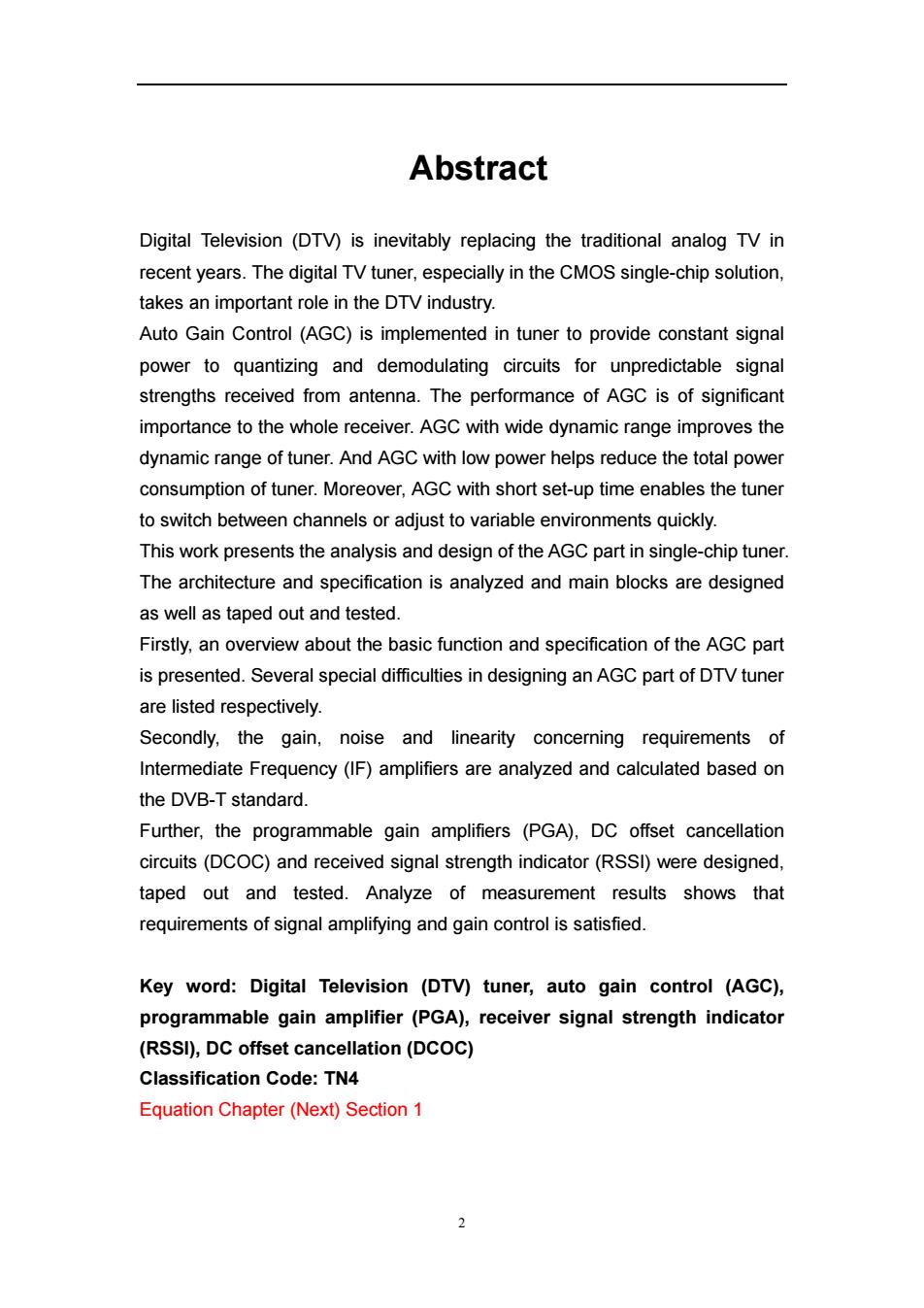正在加载图片...

Abstract Digital Television (DTV)is inevitably replacing the traditional analog TV in recent years.The digital TV tuner,especially in the CMOS single-chip solution, takes an important role in the DTV industry. Auto Gain Control(AGC)is implemented in tuner to provide constant signal power to quantizing and demodulating circuits for unpredictable signal strengths received from antenna.The performance of AGC is of significant importance to the whole receiver.AGC with wide dynamic range improves the dynamic range of tuner.And AGC with low power helps reduce the total power consumption of tuner.Moreover,AGC with short set-up time enables the tuner to switch between channels or adjust to variable environments quickly. This work presents the analysis and design of the AGC part in single-chip tuner. The architecture and specification is analyzed and main blocks are designed as well as taped out and tested. Firstly,an overview about the basic function and specification of the AGC part is presented.Several special difficulties in designing an AGC part of DTV tuner are listed respectively. Secondly,the gain,noise and linearity concerning requirements of Intermediate Frequency(IF)amplifiers are analyzed and calculated based on the DVB-T standard. Further,the programmable gain amplifiers (PGA),DC offset cancellation circuits(DCOC)and received signal strength indicator(RSSI)were designed, taped out and tested.Analyze of measurement results shows that requirements of signal amplifying and gain control is satisfied. Key word:Digital Television (DTV)tuner,auto gain control (AGC), programmable gain amplifier(PGA),receiver signal strength indicator (RSSI),DC offset cancellation(DCOC) Classification Code:TN4 Equation Chapter(Next)Section 1 22 Abstract Digital Television (DTV) is inevitably replacing the traditional analog TV in recent years. The digital TV tuner, especially in the CMOS single-chip solution, takes an important role in the DTV industry. Auto Gain Control (AGC) is implemented in tuner to provide constant signal power to quantizing and demodulating circuits for unpredictable signal strengths received from antenna. The performance of AGC is of significant importance to the whole receiver. AGC with wide dynamic range improves the dynamic range of tuner. And AGC with low power helps reduce the total power consumption of tuner. Moreover, AGC with short set-up time enables the tuner to switch between channels or adjust to variable environments quickly. This work presents the analysis and design of the AGC part in single-chip tuner. The architecture and specification is analyzed and main blocks are designed as well as taped out and tested. Firstly, an overview about the basic function and specification of the AGC part is presented. Several special difficulties in designing an AGC part of DTV tuner are listed respectively. Secondly, the gain, noise and linearity concerning requirements of Intermediate Frequency (IF) amplifiers are analyzed and calculated based on the DVB-T standard. Further, the programmable gain amplifiers (PGA), DC offset cancellation circuits (DCOC) and received signal strength indicator (RSSI) were designed, taped out and tested. Analyze of measurement results shows that requirements of signal amplifying and gain control is satisfied. Key word: Digital Television (DTV) tuner, auto gain control (AGC), programmable gain amplifier (PGA), receiver signal strength indicator (RSSI), DC offset cancellation (DCOC) Classification Code: TN4 Equation Chapter (Next) Section 1